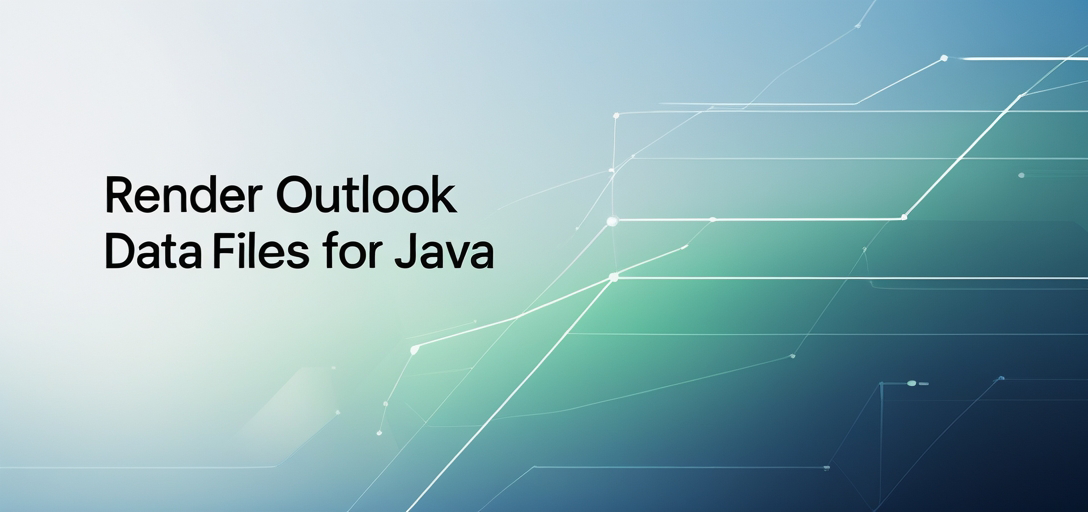How to Render Outlook Data Files Using GroupDocs.Viewer in Java: A Step-by-Step Guide
Introduction
Rendering messages from Outlook data files directly within a Java application? Use the powerful GroupDocs.Viewer library for this purpose. This tutorial demonstrates how to display contents of an OST or PST file’s Inbox folder as HTML pages embedded with resources, making it ideal for integrating email functionalities into your Java applications.

What You’ll Learn:
- Configuring GroupDocs.Viewer in a Java project.
- Rendering messages from the Inbox folder of Outlook data files.
- Key configuration options and troubleshooting tips.
- Real-world applications of rendering Outlook Data Files using Java.
Before diving into implementation, ensure your setup is correct.
Prerequisites
To effectively follow this tutorial, make sure you have:
Required Libraries, Versions, and Dependencies
- GroupDocs.Viewer for Java: Version 25.2 or later.
- Maven (recommended) for managing dependencies.
Environment Setup Requirements
- A Java Development Kit (JDK) installed on your system.
- An IDE like IntelliJ IDEA or Eclipse with Maven support configured.
Knowledge Prerequisites
- Basic understanding of Java programming and project structure.
- Familiarity with using Maven is helpful but not mandatory.
Setting Up GroupDocs.Viewer for Java
Setting up the GroupDocs.Viewer library in your Java environment is straightforward, especially with Maven. Here’s how to get started:
Maven Configuration
Add the following configuration to your pom.xml file to include GroupDocs.Viewer as a dependency:
<repositories>
<repository>
<id>repository.groupdocs.com</id>
<name>GroupDocs Repository</name>
<url>https://releases.groupdocs.com/viewer/java/</url>
</repository>
</repositories>
<dependencies>
<dependency>
<groupId>com.groupdocs</groupId>
<artifactId>groupdocs-viewer</artifactId>
<version>25.2</version>
</dependency>
</dependencies>
License Acquisition Steps
- Free Trial: Download a trial version from GroupDocs to explore its features.
- Temporary License: Request a temporary license for full access during development at GroupDocs Temporary License Page.
- Purchase: For production use, purchase a license from GroupDocs Purchase.
Basic Initialization and Setup
Once the dependency is added, you’re ready to start using GroupDocs.Viewer in your Java application. Initialize the Viewer with the path of your Outlook data file:
import com.groupdocs.viewer.Viewer;
import com.groupdocs.viewer.options.HtmlViewOptions;
public class RenderOutlookDataFiles {
public static void main(String[] args) {
String outputDirectory = "YOUR_OUTPUT_DIRECTORY";
try (Viewer viewer = new Viewer("YOUR_DOCUMENT_DIRECTORY/SAMPLE_OST_SUBFOLDERS")) {
// Further configuration and rendering logic will go here
}
}
}
Implementation Guide
Now, let’s break down the implementation into actionable steps:
Configuring Output Directory and File Paths
First, define where your rendered HTML files should be saved. Specify this directory in your code and format the output file paths accordingly.
Define Output Directory Path
String outputDirectory = "YOUR_OUTPUT_DIRECTORY"; // Replace with actual path
This directory will hold all generated HTML pages from your Outlook data file’s Inbox folder.
Setting Up View Options for Rendering
Next, configure HtmlViewOptions to specify how you want the rendering to occur. This includes setting paths and enabling embedded resources for better presentation:
Configure HTML View Options with Embedded Resources
String pageFilePathFormat = String.format("%s/page_{0}.html", outputDirectory);
HtmlViewOptions viewOptions = HtmlViewOptions.forEmbeddedResources(pageFilePathFormat);
This snippet sets up the path format for each rendered page and ensures resources are embedded within the HTML files.
Specifying Outlook Folder to Render
To focus on rendering messages specifically from the Inbox folder, configure OutlookOptions:
Set Outlook-Specific Rendering Options
viewOptions.getOutlookOptions().setFolder("Inbox"); // Adjust based on your file's language settings if necessary
This line tells GroupDocs.Viewer to only render emails from the Inbox folder.
Initializing and Using Viewer for Rendering
With configurations in place, initialize the Viewer object with your Outlook data file path and call the view() method:
Render the Document
try (Viewer viewer = new Viewer("YOUR_DOCUMENT_DIRECTORY/SAMPLE_OST_SUBFOLDERS")) {
viewer.view(viewOptions);
}
This block initializes the Viewer and starts rendering the specified folder’s messages into HTML format.
Practical Applications
Here are some practical scenarios where you can apply this feature:
- Email Archiving Solutions: Integrate with systems that require archiving emails for compliance or historical records.
- Custom Email Clients: Develop custom email clients that need to display content from PST files natively in a web interface.
- Data Migration Tools: Create tools that migrate emails from PST to other formats, ensuring data integrity and accessibility.
Performance Considerations
When rendering large Outlook data files, consider these performance tips:
- Optimize memory usage by managing resources efficiently within your application.
- Ensure adequate system resources are available for processing large volumes of email data.
- Follow best practices in Java memory management when using GroupDocs.Viewer to prevent leaks and excessive consumption.
Conclusion
You’ve now learned how to render messages from Outlook data files using GroupDocs.Viewer for Java. This capability can be a powerful addition to your software solutions, offering flexibility and control over email content presentation.
Next Steps:
- Experiment with different rendering configurations.
- Explore additional features of the GroupDocs.Viewer library.
Call-to-Action: Try implementing this solution in your next project or application!
FAQ Section
Here are some common questions you might have:
- What is GroupDocs.Viewer for Java?
- A powerful document viewing library that supports rendering various file formats, including Outlook data files.
- Can I render PST files with GroupDocs.Viewer in Java?
- Yes, GroupDocs.Viewer supports both OST and PST file types.
- How do I handle large Outlook data files efficiently?
- Optimize your environment’s memory settings and manage resources carefully within the application.
- What are some alternatives to using GroupDocs.Viewer for rendering emails in Java?
- You could use native libraries provided by Microsoft or other third-party libraries, though they might not offer the same flexibility and ease of integration.
- Where can I find more information about customization options with GroupDocs.Viewer?
- Check out the GroupDocs Viewer Java Documentation for detailed guides on customization and advanced features.
Resources
- Documentation: GroupDocs Viewer Java Documentation
- API Reference: GroupDocs Viewer Java API Reference
- Download: GroupDocs.Viewer for Java Download
- Purchase: Buy GroupDocs License